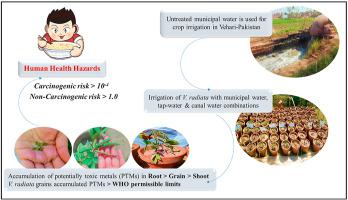Chemosphere ( IF 8.1 ) Pub Date : 2020-11-27 , DOI: 10.1016/j.chemosphere.2020.129124 Hasnain Anwar , Muhammad Shahid , Natasha , Nabeel Khan Niazi , Sana Khalid , Tasveer Zahra Tariq , Sajjad Ahmad , Muhammad Nadeem , Ghulam Abbas

|
Depending on the use and management, wastewater generation can be a severe environmental dilemma or a potential source. Proper application and management of municipal water (MW) in agriculture could be its sustainable use. Until now, there is rare data about the combined application of wastewater and freshwater in agriculture that could be considered as sustainable water management strategy. Also, plant (oxidative) stress responses to wastewater application have been rarely investigated. Here, we elucidated the influence of MW irrigation, diluted with canal water (CW) and groundwater (tap water; TW), on Vigna radiata to evaluate (i) the accumulation of potentially toxic metal(loid)s (PTMs; arsenic, copper, cadmium, iron, manganese, lead, nickel, zinc) in different plant tissues, (ii) biochemical modifications in plants, (iii) relative compartmentation of PTMs inside plant, and (iv) PTMs-induced health risk. Results revealed that the soil-plant transfer of PTMs and physiological changes in V. radiata varied depending on the irrigation water type. Noticeably, plants sequestered most of the PTM contents in roots (average 64%) and less were translocated to plant shoots. All the irrigation treatments provoked oxidative stress in V. radiata with high production of hydrogen peroxide, followed by an oxidation of membrane lipids and a decrease in chlorophyll content. The estimated cancer risk and hazard quotients values revealed a potential risk to human health (HQ: 2.2-108.8, CR: 0.0002-0.664), especially for arsenic, cadmium and lead. The integrated risk estimated from PTMs highlighted the unsuitability of all the treatments for crop irrigation. Therefore, in areas with high PTM levels in MW and freshwaters their mixed use is not an ideal management practice. Conclusively, this study helps to strictly monitor the quality of irrigation water before applying to crops and develop a suitable management and remediation strategy.
中文翻译:

废水和淡水灌溉下Vigna radiata L.的潜在有毒金属(类)风险评估
根据使用和管理,废水的产生可能是严重的环境难题或潜在的污染源。农业中市政水的适当应用和管理可能是其可持续利用。到目前为止,关于废水和淡水在农业中的综合应用的罕见数据可被视为可持续的水管理策略。而且,很少研究植物(氧化)胁迫对废水处理的响应。在这里,我们阐明MW灌溉的影响,用运河水(CW)和地下水(自来水; TW)稀释,对绿豆评估(i)不同植物组织中潜在有毒金属(PTMs;砷,铜,镉,铁,锰,铅,镍,锌)的积累,(ii)植物的生化修饰,(iii)植物内部PTM的相对间隔,以及(iv)PTM引起的健康风险。结果表明,PTM的土壤-植物转移和辐射弧菌的生理变化取决于灌溉水的类型。值得注意的是,植物从根部吸收了大部分PTM含量(平均64%),而较少的植株转移到了植物的芽中。所有灌溉处理均引起辐射弧菌的氧化应激。产生大量的过氧化氢,然后氧化膜脂并降低叶绿素含量。估计的癌症风险和危害商值显示出对人类健康的潜在风险(总部:2.2-108.8,CR:0.0002-0.664),尤其是砷,镉和铅。通过PTM估算的综合风险突显了所有作物灌溉方法都不适合。因此,在兆瓦级水和淡水中PTM含量高的地区,混合使用不是理想的管理方法。总之,这项研究有助于严格监测灌溉水的质量,然后再应用于作物,并制定适当的管理和补救策略。











































 京公网安备 11010802027423号
京公网安备 11010802027423号